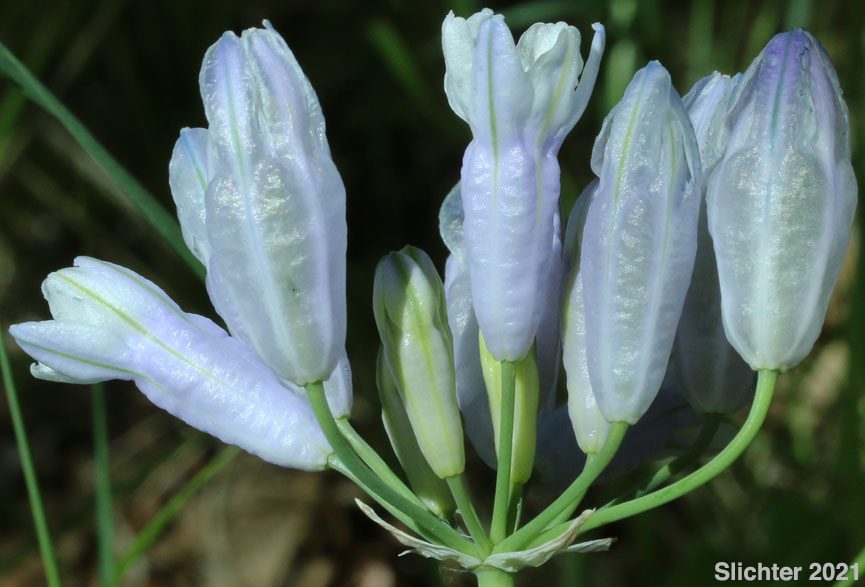[Cluster Lilies: The Genus Triteleia
East of the Cascade Mountains of Oregon and Washington]
Bicolored Cluster Lily, Howell's Triteleia, Large-flowered Triteleia
Triteleia grandiflora
Synonyms: Brodiaea bicolor, Brodiaea douglasii var. howellii, Brodiaea howellii, Triteleia grandiflora ssp. grandiflora, Triteleia grandiflora var. howellii, Triteleia howellii
 -
- 

Bicolored cluster lilies as seen on the west bank of the John Day River about one and one-half miles downstream from the Cottonwood Canyon State Park campground........April 6, 2015. The blue-flowered form (former var.
douglasii) is also found at this location.
 The photo at right shows a view down onto the tepals of bicolored cluster lily . Note that the margins of the tepals are only slightly ruffled. Photographed at Memaloose in the central Columbia River Gorge..........April 24, 2006
The photo at right shows a view down onto the tepals of bicolored cluster lily . Note that the margins of the tepals are only slightly ruffled. Photographed at Memaloose in the central Columbia River Gorge..........April 24, 2006.
Characteristics:
Bicolored cluster lily is a pretty prairie wildflower with
a single stem arising from 20-70 cm in height from a deep seated, scaly
corm. A pair of linear, grass-like leaves arise from the base of the plant.
The leaves are flat but keeled beneath, ranging from 25-50 cm long and from
3-10 mm wide.
The inflorescence is a compact umbel, the pedicels ranging
from 5-20 mm long. The flowers consist of six fused tepals, forming a tube
about 7 to 10 mm long. The tips of the tepals are free. The color of the
tepals is white to fairly deep blue, with deeper blue midline stripes running
the length of the tepals. Coastal plants may be a deeper blue. Inland plants
are much lighter, helping distinguish them from Douglas'
Brodiea where their ranges overlap.
The tepals are generally about the same size and are flared
equally away from the tube at about the same level. The outer series of
tepals are broadly lanceolate in shape without ruffled edges, the inner
series oblong or obovate in shape, sometimes with slightly ruffled margins.
The anthers range from yellow to light blue and measure from 2.5-3 mm long.
Bicolored cluster lily is very similar in appearance
to
Douglas' Brodiea. The latter usually has a more
open inflorescence with flowers of a deeper blue hue. In addition, the tepals
not equal in shape. The inner are broader and with noticeably ruffled margins,
the outer tepals oblong-lanceolate without ruffles to slightly ruffled.
Habitat:
The bicolored cluster lily may be found on
the grassy bluffs of coastal headlands as well as on arid prairies and among
sagebrush at lower elevations.
Range:
The bicolored cluster lily is found from southwestern
British Columbia south through Puget Sound into the Willamette Valley, westward
to the coast, and eastward through the Columbia River Gorge into eastern Washington
and Oregon, where it is found at it northernmost in southern Chelan and Grant
counties in Washington and at its southernmost in Gilliam County in Oregon.
 -
- 
The photo at left shows a close-up view of the inflorescence of bicolored cluster lily as seen on a knoll alongside Oregon Highway 206 about one and a half miles west of the John Day River of north-central Oregon.........April 8, 2007. The photo at right shows the inflorescence of bicolored cluster lily as observed on balds at Brooks Memorial State Park off US 97 near Satus Pass.......June 1, 2019..
 -
- 
Bicolored cluster lily blooming along the Hard Stone Trail, Cottonwood Canyon State Park and adjacent BLM lands......March 26, 2021.
 -
- 
Bicolored cluster lily as seen at left at Memaloose in the central Columbia River Gorge.........April 24, 2006. The photo at right shows bicolored cluster lily blooming on scablands in open garry oak forest at Brooks Memorial State Park....June 4, 2021.

Bicolored cluster lily blooming on scablands about two-thirds of a mile north of Tumwater Butte, Simcoe Mountains Unit of the Klickitat Wildlife Area......May 22, 2022.
Paul Slichter
 The photo at right shows a view down onto the tepals of bicolored cluster lily . Note that the margins of the tepals are only slightly ruffled. Photographed at Memaloose in the central Columbia River Gorge..........April 24, 2006.
The photo at right shows a view down onto the tepals of bicolored cluster lily . Note that the margins of the tepals are only slightly ruffled. Photographed at Memaloose in the central Columbia River Gorge..........April 24, 2006.